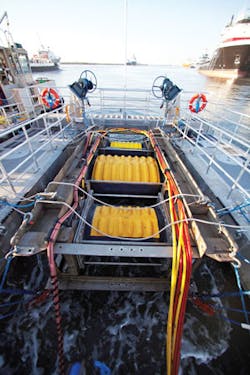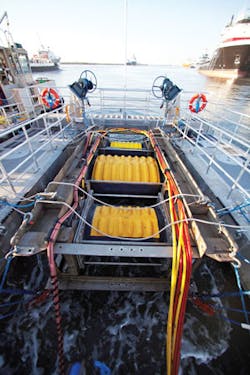Sarah Parker Musarra
Editor
As concern from regulatory bodies and special interest groups over the potential effects of seismic surveying airguns on marine life continues to amass, Houston-based Geokinetics Inc. recently deployed a second field trial of its AquaVib marine vibrator to acquire source line into an ocean bottom receiver spread.
Geokinetics’ Vice President, Business Development and Technology John Archer says AquaVib, which has been under production since the 1990s, can be an environmentally sound alternative to airgun sources in certain situations. The company does not tow streamers to acquire data, which was a factor in this decades-long development period for AquaVib. As such, Archer says the company focuses on shallow-water and transition zone acquisition, where streamers cannot be towed. This is where Geokinetics feels the marine vibrator can be a viable option to other methods. However, such areas bring their own challenges.
“We cannot tie onshore to deepwater [data] because permitting the transition zone is difficult,” he explained, due in part to groups who believe seismic acquisition is damaging marine life. Airguns have specifically been under increasing scrutiny.
In late 2016, the US Bureau of Ocean Energy Management began drafting its programmatic environmental impact statement, which evaluates the potential impacts of G&G surveys on marine mammals, fish, corals, and other environmentally sensitive species in the Gulf’s outer continental shelf. The bureau said the aim of the document is to recommend measures to protect these marine mammals and environments from potential impacts of G&G activities. From inception, it has been disputed by industry groups such as the International Association of Geophysical Contractors (IAGC) and API.
Airguns are an impulsive source that spreads a burst of instant energy, including some higher frequencies within the hearing zones of some marine mammals.
“We do not need [those frequencies generated]; it is a waste of energy,” Archer said.
Smaller than an airgun and with lower sound amplitudes, AquaVib allows the operator to control the bandwidth of the vibrator signal. A starting and stopping frequency can be programmed, so that the frequency range going into the water can be limited. The same amount of energy can also be spread out over several seconds, so that it becomes a semi-continuous source, lowering the instantaneous sound pressure level, he said.
“With that, we can stay well within the requirements the regulators around the world are starting to impose on us,” Archer said.
Field trials
In both trials, the AquaVib comprised three individual vibrators; two smaller units, which are found to be more efficient for higher frequencies, and one larger unit for lower frequencies. The units were placed in a support frame that provides mounting and lifting points for the entire unit.
The first field test of the marine vibrator was in the South Timbalier area offshore Louisiana during a 2015 3D ocean bottom survey. Data was recorded into a multi-component ocean bottom system, which the company then processed. It was compared to a conventional air source survey shot in the same location.
In a paper entitled, “Field testing the AquaVib: an alternate marine seismic source,” presented at the 2015 Society of Exploration Geophysicists conference in New Orleans, Louisiana, Geokinetics’ Bill Pramik, M. Lee Bell, Adam Grier, and Allen Lindsay, wrote: “Initial processing of the AquaVib field tests has conclusively shown that this marine vibrator can achieve comparable data quality to traditional airgun sources. Additional processing and analysis are required to fully explore the possibilities with marine Vibroseis, but this conclusion is definitive.”
The authors said the AquaVib was mounted between the hulls of catamaran barge with winches to raise and lower the vibrator. It was then towed about 65 ft (20 m) behind a utility vessel used in the test. Power and controls were mounted on the utility vessel.
Archer said that that test probably represented an industry first. For the second test, AquaVib was once again deployed in full production mode on an ocean bottom survey in the shallow-water Gulf of Mexico, where it acquired repeated passes of an 8.3-mi (13.5-km) 2D test line. In total, AquaVib acquired more than 53 mi (85 km) of source line into a 4C ocean bottom receiver spread.
The line was acquired in water depths up to 60 ft (18 m), testing multiple sweep parameters, tow depths (3, 6, 16, 33 ft or 1, 2, 5, 10 m), and VP intervals, including the company’s proprietary Symphony sweep. A second line was recorded using a shallow-water airgun array for data comparison purposes. Acquisition took place in January and February 2017.
Representatives from the IAGC were on-hand. “The geophysical industry has always been at the forefront of advancing innovation and technology to deliver geophysical data in an environmentally responsible manner,” IAGC President Nikki Martin toldOffshore. “We support our members’ continued pursuit of emerging technologies operational efficiencies to better serve the world’s need to safely and reliably identify oil and gas reserves.”
Geokinetics Vice President of Sales and Marketing David Hammer explained that a few tweaks were made in between tests. One example he gave were improvements to the auxiliary channel set-up. More channels were added to enhance the quality of the output sweeps, or the driving signals, and firing sequence timing.
Whereas the initial test run was to test how the technology gathered data under various parameters, Hammer said that the final objectives of the January-February tests were to further explore its power limits, investigate different sweep and tow depth options for production efficiency and data quality enhancement.
Geokinetics has also designed the units to be scalable, with Archer and Hammer explaining that they envisioned up to a dozen units acquiring data simultaneously.
The current units are ready for a production build, the two said, and the company is planning the next generation of AquaVib vessel. An initial design has been created for autonomous units capable of being operated remotely at slow speeds. Testing for this iteration will soon be underway.




